AMD's Ryzen 9 6900HS Rembrandt Benchmarked: Zen3+ Power and Performance Scaling
by Dr. Ian Cutress on March 1, 2022 9:30 AM ESTSimulation
Simulation and Science have a lot of overlap in the benchmarking world, however for this distinction we’re separating into two segments mostly based on the utility of the resulting data. The benchmarks that fall under Science have a distinct use for the data they output – in our Simulation section, these act more like synthetics but at some level are still trying to simulate a given environment.
DigiCortex v1.35: link
DigiCortex is a pet project for the visualization of neuron and synapse activity in the brain. The software comes with a variety of benchmark modes, and we take the small benchmark which runs a 32k neuron/1.8B synapse simulation, similar to a small slug.
The results on the output are given as a fraction of whether the system can simulate in real-time, so anything above a value of one is suitable for real-time work. The benchmark offers a 'no firing synapse' mode, which in essence detects DRAM and bus speed, however we take the firing mode which adds CPU work with every firing.
The software originally shipped with a benchmark that recorded the first few cycles and output a result. So while fast multi-threaded processors this made the benchmark last less than a few seconds, slow dual-core processors could be running for almost an hour. There is also the issue of DigiCortex starting with a base neuron/synapse map in ‘off mode’, giving a high result in the first few cycles as none of the nodes are currently active. We found that the performance settles down into a steady state after a while (when the model is actively in use), so we asked the author to allow for a ‘warm-up’ phase and for the benchmark to be the average over a second sample time.
For our test, we give the benchmark 20000 cycles to warm up and then take the data over the next 10000 cycles seconds for the test – on a modern processor this takes 30 seconds and 150 seconds respectively. This is then repeated a minimum of 10 times, with the first three results rejected. Results are shown as a multiple of real-time calculation.
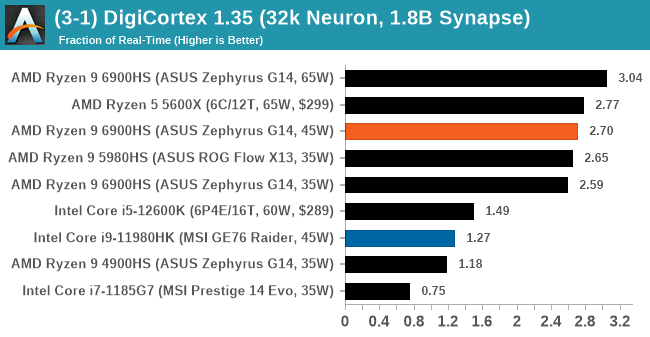
Dwarf Fortress 0.44.12: Link
Another long standing request for our benchmark suite has been Dwarf Fortress, a popular management/roguelike indie video game, first launched in 2006 and still being regularly updated today, aiming for a Steam launch sometime in the future.
Emulating the ASCII interfaces of old, this title is a rather complex beast, which can generate environments subject to millennia of rule, famous faces, peasants, and key historical figures and events. The further you get into the game, depending on the size of the world, the slower it becomes as it has to simulate more famous people, more world events, and the natural way that humanoid creatures take over an environment. Like some kind of virus.
For our test we’re using DFMark. DFMark is a benchmark built by vorsgren on the Bay12Forums that gives two different modes built on DFHack: world generation and embark. These tests can be configured, but range anywhere from 3 minutes to several hours. After analyzing the test, we ended up going for
- A Medium World, 127x127, with 550 years, 10 civilizations and 4 megabeasts
DFMark outputs the time to run any given test, so this is what we use for the output. We loop the test for as many times possible in 30 minutes.
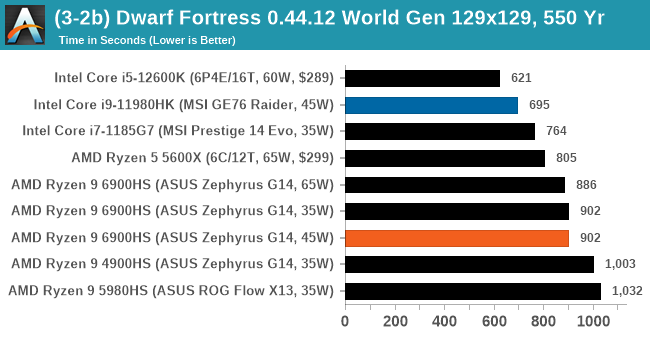
We saw a few instances where the 35W/45W results were almost identical, with the margin that the 35W would come out ahead in single threaded tasks. This may be because 35W was a fixed setting in the software options, whereas 45W was the power management framework in action.
Dolphin v5.0 Emulation: Link
Many emulators are often bound by single thread CPU performance, and general reports tended to suggest that Haswell provided a significant boost to emulator performance. This benchmark runs a Wii program that ray traces a complex 3D scene inside the Dolphin Wii emulator. Performance on this benchmark is a good proxy of the speed of Dolphin CPU emulation, which is an intensive single core task using most aspects of a CPU. Results are given in seconds, where the Wii itself scores 1051 seconds.
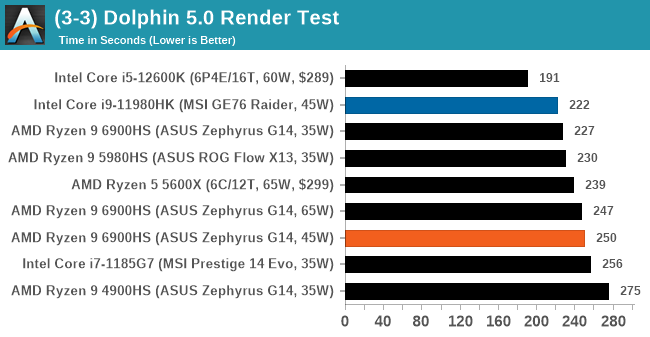
Rendering
Rendering tests, compared to others, are often a little more simple to digest and automate. All the tests put out some sort of score or time, usually in an obtainable way that makes it fairly easy to extract. These tests are some of the most strenuous in our list, due to the highly threaded nature of rendering and ray-tracing, and can draw a lot of power. If a system is not properly configured to deal with the thermal requirements of the processor, the rendering benchmarks is where it would show most easily as the frequency drops over a sustained period of time. Most benchmarks in this case are re-run several times, and the key to this is having an appropriate idle/wait time between benchmarks to allow for temperatures to normalize from the last test.
Blender 2.83 LTS: Link
One of the popular tools for rendering is Blender, with it being a public open source project that anyone in the animation industry can get involved in. This extends to conferences, use in films and VR, with a dedicated Blender Institute, and everything you might expect from a professional software package (except perhaps a professional grade support package). With it being open-source, studios can customize it in as many ways as they need to get the results they require. It ends up being a big optimization target for both Intel and AMD in this regard.
For benchmarking purposes, we fell back to one rendering a frame from a detailed project. Most reviews, as we have done in the past, focus on one of the classic Blender renders, known as BMW_27. It can take anywhere from a few minutes to almost an hour on a regular system. However now that Blender has moved onto a Long Term Support model (LTS) with the latest 2.83 release, we decided to go for something different.
We use this scene, called PartyTug at 6AM by Ian Hubert, which is the official image of Blender 2.83. It is 44.3 MB in size, and uses some of the more modern compute properties of Blender. As it is more complex than the BMW scene, but uses different aspects of the compute model, time to process is roughly similar to before. We loop the scene for at least 10 minutes, taking the average time of the completions taken. Blender offers a command-line tool for batch commands, and we redirect the output into a text file.
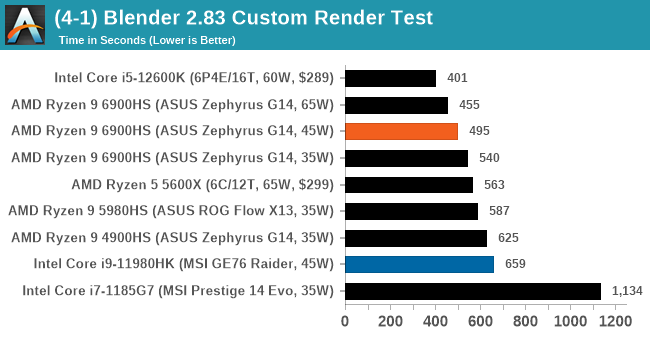
Corona 1.3: Link
Corona is billed as a popular high-performance photorealistic rendering engine for 3ds Max, with development for Cinema 4D support as well. In order to promote the software, the developers produced a downloadable benchmark on the 1.3 version of the software, with a ray-traced scene involving a military vehicle and a lot of foliage. The software does multiple passes, calculating the scene, geometry, preconditioning and rendering, with performance measured in the time to finish the benchmark (the official metric used on their website) or in rays per second (the metric we use to offer a more linear scale).
The standard benchmark provided by Corona is interface driven: the scene is calculated and displayed in front of the user, with the ability to upload the result to their online database. We got in contact with the developers, who provided us with a non-interface version that allowed for command-line entry and retrieval of the results very easily. We loop around the benchmark five times, waiting 60 seconds between each, and taking an overall average. The time to run this benchmark can be around 10 minutes on a Core i9, up to over an hour on a quad-core 2014 AMD processor or dual-core Pentium.
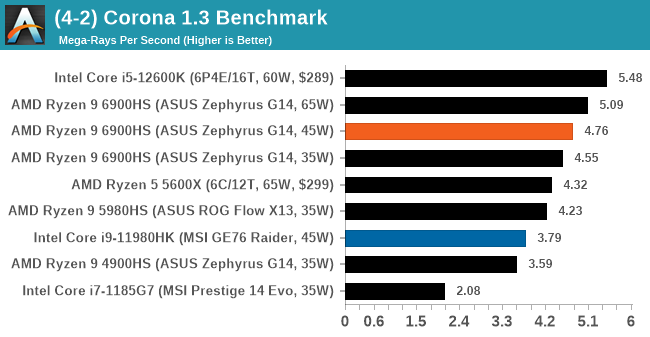
POV-Ray 3.7.1: Link
A long time benchmark staple, POV-Ray is another rendering program that is well known to load up every single thread in a system, regardless of cache and memory levels. After a long period of POV-Ray 3.7 being the latest official release, when AMD launched Ryzen the POV-Ray codebase suddenly saw a range of activity from both AMD and Intel, knowing that the software (with the built-in benchmark) would be an optimization tool for the hardware.
We had to stick a flag in the sand when it came to selecting the version that was fair to both AMD and Intel, and still relevant to end-users. Version 3.7.1 fixes a significant bug in the early 2017 code that was advised against in both Intel and AMD manuals regarding to write-after-read, leading to a nice performance boost.
The benchmark can take over 20 minutes on a slow system with few cores, or around a minute or two on a fast system, or seconds with a dual high-core count EPYC. Because POV-Ray draws a large amount of power and current, it is important to make sure the cooling is sufficient here and the system stays in its high-power state. Using a motherboard with a poor power-delivery and low airflow could create an issue that won’t be obvious in some CPU positioning if the power limit only causes a 100 MHz drop as it changes P-states.
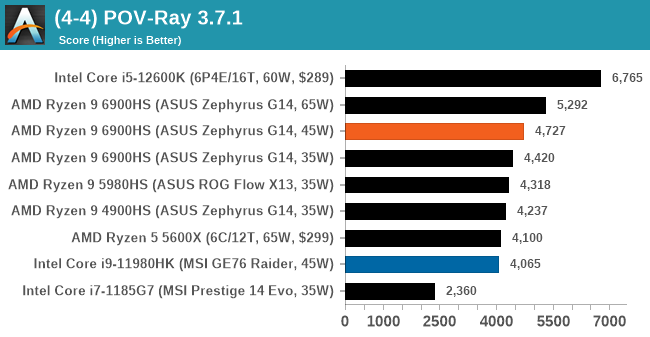
V-Ray: Link
We have a couple of renderers and ray tracers in our suite already, however V-Ray’s benchmark came through for a requested benchmark enough for us to roll it into our suite. Built by ChaosGroup, V-Ray is a 3D rendering package compatible with a number of popular commercial imaging applications, such as 3ds Max, Maya, Undreal, Cinema 4D, and Blender.
We run the standard standalone benchmark application, but in an automated fashion to pull out the result in the form of kilosamples/second. We run the test six times and take an average of the valid results.

Cinebench R20: Link
Another common stable of a benchmark suite is Cinebench. Based on Cinema4D, Cinebench is a purpose built benchmark machine that renders a scene with both single and multi-threaded options. The scene is identical in both cases. The R20 version means that it targets Cinema 4D R20, a slightly older version of the software which is currently on version R21. Cinebench R20 was launched given that the R15 version had been out a long time, and despite the difference between the benchmark and the latest version of the software on which it is based, Cinebench results are often quoted a lot in marketing materials.
Results for Cinebench R20 are not comparable to R15 or older, because both the scene being used is different, but also the updates in the code bath. The results are output as a score from the software, which is directly proportional to the time taken. Using the benchmark flags for single CPU and multi-CPU workloads, we run the software from the command line which opens the test, runs it, and dumps the result into the console which is redirected to a text file. The test is repeated for a minimum of 10 minutes for both ST and MT, and then the runs averaged.
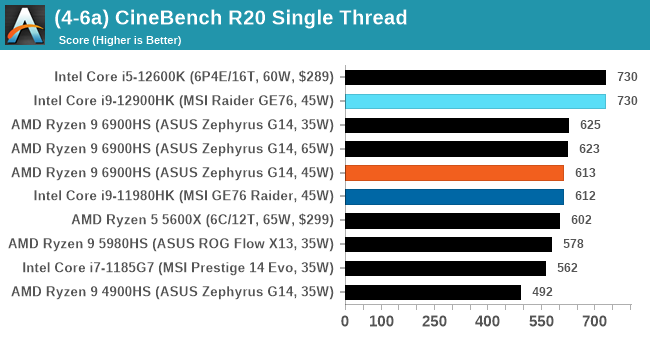
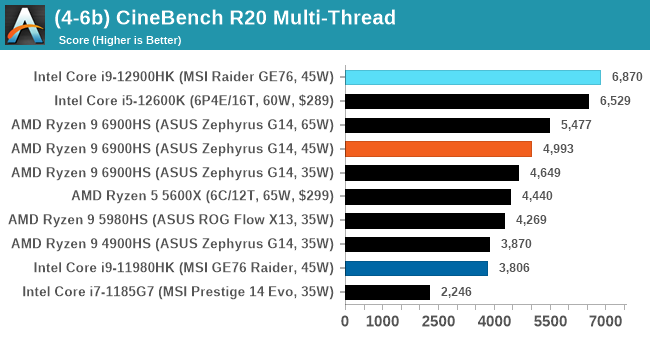










92 Comments
View All Comments
Kangal - Sunday, March 6, 2022 - link
Zeno, Guards of Zeno, Grand Priest, Whis/Angels, Awakened Gass, Ultra Granolah, Ultra Instinct Goku, Beerus/GoDs, Fused Zamasu, Prime Moro, Raged Broly, Ultra Ego Vegeta, Full-power Jiren, LSS Kefla, Destruction Toppo, Max Hit, Anilaza, SSJ Rose Black, Golden Frieza, Dyspo, LSS Kale, Spirit Future Trunks, Super Ribrianne, Trained #17, Ultimate Gohan, Buu, Seven-Three.GeoffreyA - Monday, March 7, 2022 - link
Astonishing, and thanks for that! Remembering only Buu, Ultimate Gohan, and a bit of Beerus, I am really out of touch with DB canon!Kangal - Tuesday, March 8, 2022 - link
You can find the new series Dragon Ball Super online or even youtube. There is also the official manga which you can read for free* here:https://www.viz.com/shonenjump/chapters/dragon-bal...
*only the latest three issues available, new issues always free.
GeoffreyA - Tuesday, March 8, 2022 - link
Thanks, I only saw the first 10-15 episodes of Super in 2018, where Beerus came to the cruiseship, and still hope to watch the rest of it, eventually. It was nostalgic, I remember, seeing these dear characters after so long.mode_13h - Wednesday, March 9, 2022 - link
Eh, I only watched the original series. The few things after it that I had seen lacked the same charm. And among that series, the first season was one of the best. The censors had clearly cracked down on it, after that.What I thought worked so well about the original DB was Goku's innocence, ignorance, indomitable spirit, and purity of heart. That made it so much more entertaining and gratifying to see him overcome all the obstacles and enemies he encountered. And it's almost as if not knowing his own limitations made him unrestrained by them.
GeoffreyA - Thursday, March 10, 2022 - link
That's an exact description of Goku's character and is likely the secret of his greatness and why he often prevailed over his enemies. I would add that forgiveness was another trait of his, and something they could never understand. It's almost paradoxical, at least in DBZ, how he was the comic clumsy figure, and yet when it came to saving the world, only he could do it. Without knowing it, people are emulating, I feel, more of Vegeta's cynical character today. What the world needs is more of Goku.mode_13h - Friday, March 11, 2022 - link
I haven't watched much since the mid 2000's, but I thought Luffy, in One Piece, had a similar personality. However, he seemed to have a mercurial wisdom and canniness, just beneath the surface. In that regard, he seemed to have echos of Irresponsible Captain Taylor.I don't remember too much of Naruto, though I had started watching it from the beginning. Like Goku, he also had an innocence and indomitably, but there was obviously a darkness about him and inside of him.
I wouldn't have patience for any of that, now. Even at the time, it seemed rather excessively drawn out.
BTW, did you see the live action DB movie? I think it was made around 2008? More of a Hollywood movie; not Japanese. I'm apparently among the small minority who actually liked it. It helps to remember that Dragon Ball itself is loosely based on the ancient tale of Saiyuki and just don't expect a direct translation from the TV series or manga. It's very much a reinterpretation, but I enjoyed it.
GeoffreyA - Monday, March 14, 2022 - link
Luffy is very like Goku, regarding his innocence, simplicity, and goodness, but yes, he had another element which is hard to pin down. Perhaps a certain stoic quality that clicked on at times, and made him something fearful to all those who practised evil. (It's even evident when they left the Merry; Goku would never have operated like that, and for my part, I agree with Usopp.) I really loved One Piece. It could often be tedious and silly, but once the story knocked into gear, it was usually astonishing, and gave you the feeling of being on an adventure with noble companions. Namaka. My favourite arcs were Arlong/Nami, Arabasta, and Water 7. In 2018, I got stuck at Thriller Bark and never went on.What caused me to stop was seeing Evangelion for the first time that year. It left me a sadder, more sober person for ever; and I'll add a word of warning to others, Eva is terribly depressing and no joke. That and Steins;Gate are my favourite anime. I've heard great things about Naruto but to this day have not seen a single episode. Rurouni Kenshin was nice.
My brother really enjoyed the live-action Dragon Ball, but though I've seen only bits and pieces, I always debate with him that it's not the real DB! He contends that it's pretty good. Well, perhaps I need to sit down and actually watch it and give it a proper appraisal.
mode_13h - Tuesday, March 15, 2022 - link
Wow, all those One Piece names are definitely a flashback. I hung out with some Kenshin fans, so I saw the entire original series.Evangelion was pretty mind-blowing for me, when the original series first aired. A bit confusing, especially with the movies, the revisionist ending, and whatnot.
More recently, I went to a marathon showing of the original series, back when they started releasing the new version. I watched the first 2-3 installments of the new version and just quit. It got too absurd for me. I never liked the direction Gainax took with FLCL, but I guess it was inevitable the new Eva would go there (and lose me). I did really like Kare Kano and Chobits (lol, they seemed to have HDDs inside!).
I got a lot from Evangelion, but I'm pretty much over it. Not unlike how I parted ways with the Star Wars franchise, more than a decade ago. I just don't need it. I don't seem to have trouble finding enough to watch. For instance, a movie I recently enjoyed was Arrival.
Even the news is like a high-tension drama, for at least the past half decade. I can really feel like I'm living through history. It gives me a new perspective on much of the past century and what it was probably like, at the time.
Some other old anime that's fun to re-watch are the original Patlabor OAV series and movies, Akira, and the Ghost in the Shell series and movies. And every time I hear about space junk in the news, my mind goes back to Planetes.
GeoffreyA - Tuesday, March 15, 2022 - link
Evangelion is indeed out of this world. It's really the sadness of the characters that touched me, though of course the relentless, minimal action was impressive when it came. Can anyone ever forget Eva-01 breaking out of the shadow space in episode 16, or the time, nearing the end, when it reactivates though its power is gone? The new movies' weakness is that they tried to spin everything out to excessive detail, whereas the series' strength was minimalism. The characterisation, too, was subtly altered. Anyhow, last year I watched the final film, Thrice upon a Time, and can honestly say they did a good job and ended Eva on a surprisingly cheerful note, with a good message. I secretly hope for a return someday.I haven't seen most of the anime you mentioned, except for Akira and Ghost in the Shell. Suffice to say, Akira leaves the viewer speechless.
Same here. Lost my interest in Star Wars and don't care to see it again. Arrival was great, with a good performance by Amy Adams. And talking of Villeneuve movies, the new Dune was a big disappointment to me.